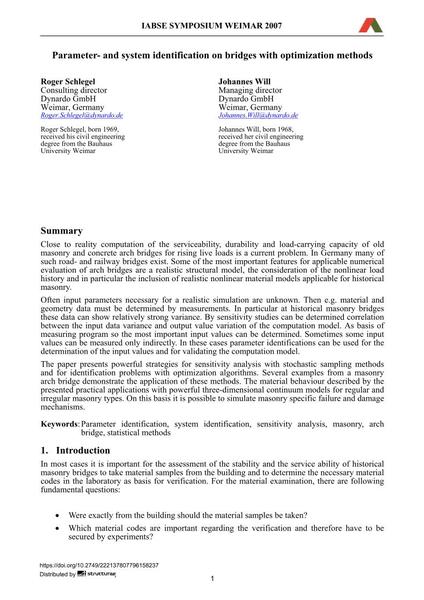Parameter- and system identification on bridges with optimization methods

|
|
|||||||||||
Détails bibliographiques
| Auteur(s): |
Roger Schlegel
Johannes Will |
||||
|---|---|---|---|---|---|
| Médium: | papier de conférence | ||||
| Langue(s): | anglais | ||||
| Conférence: | IABSE Symposium: Improving Infrastructure Worldwide, Weimar, Germany, 19-21 September 2007 | ||||
| Publié dans: | IABSE Symposium Weimar 2007 | ||||
|
|||||
| Page(s): | 348-349 | ||||
| Nombre total de pages (du PDF): | 8 | ||||
| Année: | 2007 | ||||
| DOI: | 10.2749/222137807796158237 | ||||
| Abstrait: |
Close to reality computation of the serviceability, durability and load-carrying capacity of old masonry and concrete arch bridges for rising live loads is a current problem. In Germany many of such road- and railway bridges exist. Some of the most important features for applicable numerical evaluation of arch bridges are a realistic structural model, the consideration of the nonlinear load history and in particular the inclusion of realistic nonlinear material models applicable for historical masonry. Often input parameters necessary for a realistic simulation are unknown. Then e.g. material and geometry data must be determined by measurements. In particular at historical masonry bridges these data can show relatively strong variance. By sensitivity studies can be determined correlation between the input data variance and output value variation of the computation model. As basis of measuring program so the most important input values can be determined. Sometimes some input values can be measured only indirectly. In these cases parameter identifications can be used for the determination of the input values and for validating the computation model. The paper presents powerful strategies for sensitivity analysis with stochastic sampling methods and for identification problems with optimization algorithms. Several examples from a masonry arch bridge demonstrate the application of these methods. The material behaviour described by the presented practical applications with powerful three-dimensional continuum models for regular and irregular masonry types. On this basis it is possible to simulate masonry specific failure and damage mechanisms. |
||||
| Mots-clé: |
pont en arc
|
||||
